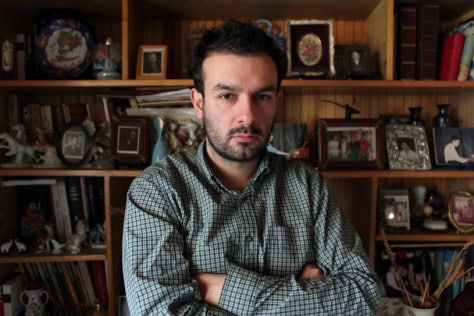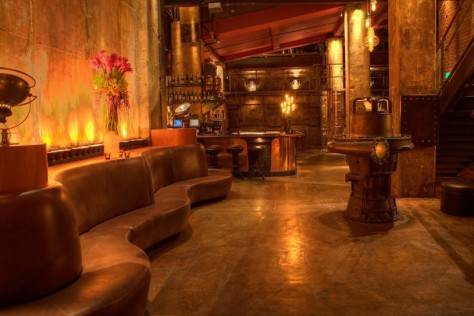With a dictionary definition influx of Swedish threads pouring into the States―everything from colorful socks to trendy three-piece suits―we can't help but wonder just what the heck's going on in other parts of Scandinavia. After all, everyone needs clothes―especially when you live that far north!―and there's no way that the Danes and Norwegians are milling about in classic fisherman's sweaters while their stylish Stockholm siblings are stealing the spotlight.
Needless to say, Denmark and Norway (and, if you think Finland is a part of Scandinavia, that country too) are brimming with creative labels for just about ever walk of life. The one Oslo-based brand that has caught out eye this year, though, is Anti Sweden, a denim producer with a spectacular them-are-fightin'-words name. We got hooked up with a pair of the Nordic black jeans just a bit over a week ago and are in love. They fit like a glove (the cut is similar to Levi's'), have a spectacular wash that shimmers just a little bit, and feature trademark bright yellow buttons. We chatted with co-founder Kjetil Wold to better understand the company (and its parent design firm, Anti), it's black metal obsession, its feelings towards the Swedes, and much more. Read on and buy your own pair, stat!
What are your full names and titles at Anti Sweden?
Kjetil Wold Creative Director, co-founder; Kenneth Pedersen Manager, co-founder; Ellen Østmoen, consultant/co-founder; Rico Iriyama, project manager.
How many people work at the company? What are each of your rolls and how do you interact, collaborate?
We are an apparel company and a design company. In total, we are nine people working on and off with the brand Anti Sweden. We have different skills and use them [in whatever areas] we are in need of competence. Since we have a broad variety of strengths within the company we are able to adapt to the challenges ahead of us.
Naming your brand Anti Sweden seems like a pretty bold―albeit cheeky and clever―move to make. What inspired you to call it such? A resentment for today's influx of Swedish designers? A reminder that Norway is a creative country in Scandinavia as well?
We decided on the name for numerous reasons. First, as you point out, we were tired of being exposed to Swedish designers, and also Oslo is highly populated by Swedes. We had to make
a statement to prove that Norway is also a part of the creative Scandinavia. Creating a brand name which takes up the fight that has always existed between our two countries is a good way of
[strengthening] a Scandinavian denim brand, and nothing feels better than using their country name as the sales pitch! Anti is, by the way, an acronym for A New Type of Interference and we are constantly looking for that in our work and how we communicate.
On that note, how do you feel about what's coming out of Sweden today, particularly in the world of fashion? There are a tremendous number of garment designers (not manufacturers―those are all overseas!), many of which enjoy relative international success.
We are, of course, full of hate and envy…
No! We find that the success of the Swedes definitely opens up the doors to Scandinavian design―we just want to have our own take on it. I believe that a true story and [solid] brand values are the most important things when creating a label―and the more the merrier. But, as always, if everyone is following the same recipe, it gets boring and dull.
From a layman's outlook, it seems especially trying and laborious to start a brand today, yet also really simple and straightforward, thanks to the ease with which we communicate and interact throughout the “global village.” What sets Anti Sweden apart? What drove you to start your own company? Where do you see your success lying?
Todays markets are opening up to businesses that allow themselves to think different. By using knowledge, interference, and guts to build your brand, you can reach out to your target audience by new channels and challenge old business models. Large brands are being challenged by new thoughts and new ways of communicating; the regular rules are no longer the only ones. If you are good at building stories, know how to design, and stick out in a crowd, you have a fair chance of making it. The world has become much smaller and this opens [everything] up for brands like ours. Our knowledge of building brand strategies and designing for international apparel comapnies like Levi's and Diesel gave us a good start on how to break with what we knew!
Jeans are one of the most ubiquitous fashion items around, so I'm interested to know why you decided to produce them instead of shirts of shoes or something else uniform or generic.
Jeans are a basic item [that have always had a] history of rebellion and youth rage. We thought it had gone missing and found a perfect match with a culture of rage and independence, and it was luckily
right in our own backyard―black metal is, maybe, today the only true sub-culture that could claim some kind of bona fide rebellion.
Do you aspire to add to your collection and begin making other garments (like Cheap Monday or Nudie) or do you want to stick with denim?
We are first of all a pure denim label, but some garments and jewelry [have been and will continue to be] added to create a wider understanding of our brand values.
I'm intrigued by the aesthetic of the brand. You seem quiet metal-y and severe, but you use yellow buttons for decoration and integrate hand-drawn pictures into your look book. What is your stylistic theme and what does it mean to you?
The yellow buttons are a contrast to the black―they create a unique differentiator to regular black jeans―and, of course, a link to the color of the Swedish flag! The illustrations are made by gore artist Justin Bartlett, who is famous for his grim, detailed “killustrations” for the black metal scene. Being true to the way we present our culture is very important.
Collaboration is a big part of the fashion world today. Are there any people you have or will partner with? Any brands? Are you excited by such unifications (say, Jil Sander X Uniqlo) or are you hesitant to embrace them?
We have a couple of colabs up our sleeve. We have a big surprise coming up next year with a artist we have always wanted to collaborate with so we are doing it as long as it is beneficial to both parties.
When it comes to larger brands who would like to taste real rebellion, there are a couple we could work with… others, not again. I think it would be a great colab if we did something together with Cheap Monday…
What draws you most to the art of garment manufacturing? Is it the designing of the clothes? The wearing of them? The innate self-expression?
The garments need to fit in a proper way, obviously. I find it the most exiting to find attributes that don't necessarily belong to [one] gender, but add an emotional value to the product. Unexpectedness.
You can learn a lot from someone by knowing what they do in their spare time. What are some of your hobbies and interests? Are you a reader? An audiophile? An amateur chef?
I love music. Everything from True Norwegian Black Metal―like 1349―to Sonic Youth, Sunn0))), and Pavement. Graphic design is my second big interest in life, and besides that, I love riding my longboard [during the] summer and enjoying the cold winter landscapes up north.
I'm of the persuasion that environment always affects one's work and general demeanor. Since Norway has such an incredible, one-of-a-kind landscape and goes through long spans of darkness or light, I wonder how it influences your work.
Having four seasons through the year makes you appreciate the different stages of each season. It opens up for darkness and light―something everyone carries inside themself. It's an important fact of life.
 Q&A with Larry Gus
Q&A with Larry Gus We Own the Night: The Edison
We Own the Night: The Edison
No Comments